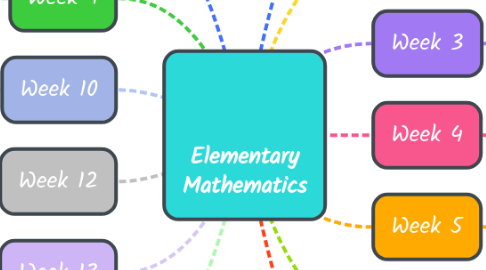
1. Week 8
1.1. Decimals
1.1.1. Place Value
1.1.2. Expanded Form
1.1.3. Block Representation
1.1.4. Multiplication and Division (see Week 9)
1.2. Fractions
1.2.1. Terminating Decimal
1.2.2. Non terminating Decimal
1.3. Percentages
2. Week 9
2.1. Scientific Notation
2.2. Multiplication of Decimals
2.3. Division of Decimals
3. Week 10
3.1. Percentages
3.1.1. Percent of Change
4. Week 12
4.1. Fractions
4.1.1. Representing Fractions
4.1.1.1. Number Line
4.1.1.2. Cuisenaire Rods
4.1.1.3. Pictures
5. Week 13
5.1. Adding Fractions
5.2. Subracting Fractions
6. Week 14
6.1. Multiplying Fractions
6.2. Dividing Fractions
7. Week 1
7.1. The Story of One
7.2. Ancient Number Systems
8. Week 2
8.1. Base Systems
8.1.1. Base 3
8.1.2. Base 10
8.1.3. Base 7
9. Week 3
9.1. Order of Operations
9.2. Addition Algorithms
9.2.1. Standard
9.2.2. Partial Sums
9.2.3. Lattice
9.2.4. Column
9.2.5. Opposite Change
9.3. Properties of Real Numbers
9.3.1. Commutative Property of Addition and Multiplication
9.3.2. Associative Property of Addition and Multiplication
9.3.3. Identity Property of Addition and Multiplication
9.3.4. Inverse Property of Addition
9.3.5. Inverse Property of Multiplication
9.3.6. Distributive Property
9.3.7. Multiplication Property of Zero
9.3.8. Multiplication Property of -1
10. Week 4
10.1. Subtraction Algorithms
10.1.1. Expanded Form
10.1.2. Equal Addends
10.2. Multiplication Methods
10.2.1. Build up Method
10.2.2. Multiplication with base 10 blocks
10.2.3. Multiplication arrays
11. Week 5
11.1. Divisibility Rules and Number Theories
11.1.1. Divisible by 2
11.1.2. Divisible by 3
11.1.3. Divisible by 4
11.1.4. Divisible by 5
11.1.5. Divisible by 6
11.1.6. Divisible by 9
11.1.7. Divisible by 10
11.1.8. Divisible by 11
11.2. Greatest Common Divisor (GCD)
11.2.1. Colored Rods
11.2.2. Prime Factorization
11.2.3. Intersection of Sets
11.3. Least Common Multiple (LCM)
11.3.1. Colored Rods
11.3.2. Prime Factorization
11.3.3. Number Line
11.3.4. Intersection of Sets
11.3.5. Division by Primes
12. Week 6
12.1. Integers
12.1.1. Positive and Negative Integers
12.1.2. Absolute Value of Integers
12.1.3. Describing Integers
12.1.3.1. Pictorially
12.1.3.2. Concretely
12.1.4. Adding Integers
12.1.4.1. Number Line
12.1.4.2. Chip Model
12.1.5. Subtracting Integers
12.1.5.1. Number Line
12.1.5.2. Charged Model
12.1.5.3. Chip Model
13. Week 7
13.1. Integers
13.1.1. Multiplication
13.1.1.1. Properties of Multiplication of Integers
13.1.1.1.1. Communative Property
13.1.1.1.2. Associative Property
13.1.1.1.3. Distributive Property
13.1.1.1.4. Zero Property
13.1.1.1.5. Identity of One
13.1.1.1.6. Inverse Property
13.1.1.2. Multiplying Using a Number Line
13.1.1.3. Multiplying Using a Chip Model
13.1.1.4. Multiplying Using a Charge Model
13.2. Type of Numbers
13.2.1. Real
13.2.2. Integers
13.2.3. Rational
13.2.4. Irrational
13.2.5. Natural
13.2.6. Imaginary
